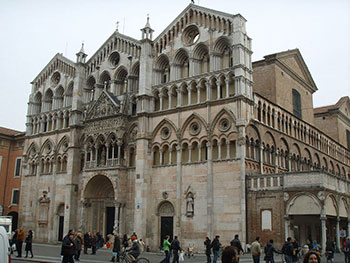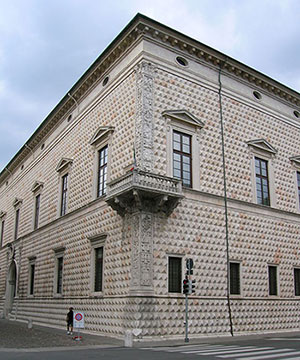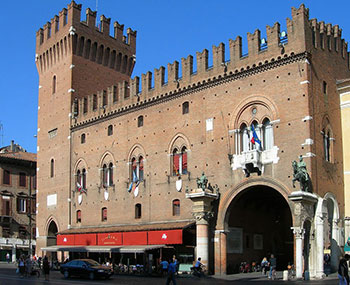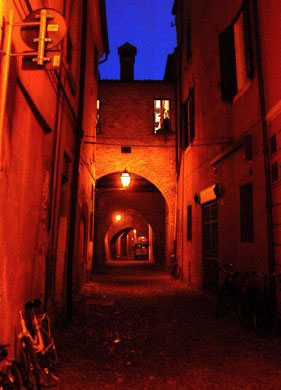We may trace the history of the luthier’s art in Ferrara back to its beginnings around the middle of the 15th century, a period of cultural development fostered by the patronage and love for the arts of Prince Leonello of the House of Este ( 1441 – 1450 ). With the overcoming of politically difficult times, of wars and famine, Leonello (a man of great culture) sought to put a new face on the city’s social life and on its territory by inviting the most important and famous men of letters, scientists and artists from all over Europe to his court.

Literary and musical theatre flourished in those years, a trend that was continued and developed with astute passion by the first Duke of Ferrara Borso d’Este (1450 – 1471) and thereafter by Ercole I (1471 – 1505), who by that time found an environment ripe for renewal and a complete renovation of the musical environment of the court. His passion for music was such that immediately on becoming Duke he set up a choir composed of thirty regularly salaried choristers, most of whom were foreigners.

In the 24 years of his reign, Ferrara became Europe’s leading centre of music. It was in those years, from Leonello d’Este to Ercole I, and that is from 1441 to 1505, that at least five known Violinmakers made their living in Ferrara: Antonio dai liuti, Guarino Battista, Pietrobono, Polverino Rinaldo and Gelmini Geminiano. Thanks to famous musicians like Josquin Dépres and Adriano Willert, the foundations were laid for a true Ferrarese school of music and around 1528 Willert, Verdelot and Arcadel were to bring popularity to one of the most typical musical forms of the century: the madrigal. Under Duke Alfonso II ( 1559 – 1597 ), Ferrara enjoyed the period of its greatest musical splendour. An expert musician himself, like his sisters Lucrezia and Eleonora, he was almost excessively keen to surround himself with the greatest instrumentalists, composers and singers of the time.When it came to music Alfonso spared no expense and his administrative books reveal that for the maintenance of music he spent an amount equal to the cost of maintaining his small German army, the extremely loyal Ducal guard.

After appointing Francesco Viola to direct the choir he expanded its membership to include thirty-six singers, whose number was increased to as many as sixty in case of need. The publication of several madrigal anthologies by the Ferrarese publisher Vittorio Baldini demonstrates the status attained by Ferrara after 1580 as a centre and meeting point of musical interests. The group of Ferrarese composers, which was numerically very limited in the middle of the 16th century, became so numerous toward 1590 that few other Italian cities, we are certain, could compare with it.
The last years of the sixteenth century passed in a jubilation of songs and sounds and in this context stringed musical instruments were used in practically every home. From 1550 until the death of Alfonso II in 1597, the luthiers Calabri Pier Vittorio, Gamberoni Giovanni, Cappello Giovanni Marco, Dall’ Hocha, Grappello G. M., Fontana Giovanni, Pazzagola, Cricca Alfonso, Patarino Marco and Cricca Giulio all lived and worked in Ferrara. An impressive quantity if we consider that the inhabitants of the city and surrounding areas may have numbered around 10,000, but it is strongly indicative of the degree of interest in music that marked the everyday life of Ferrara’s citizens. Following the death of Alfonso II and Ferrara’s consequent return into the hands of the Church, the echoes of those songs and those sounds which had inspired so much admiration in poets and musicians faded into a nostalgic memory.

The political and economic situation after Alfonso II certainly neither stimulated nor encouraged the pursuit of a musical life. It would take nearly 100 years before Ferrara was able to resume a musical activity worthy of interest.
Starting from the end of the 17th century, precisely, luthiers of great interest began to work there. We may consider their instruments as already belonging to the modern phase of development. In this same period Antonio Stradivari in Cremona had already fixed his models of violin construction according to the principles of the Golden Section.

From 1690 onward, starting from Alessandro Mezzadri and Giambattista Grancino (to name the most well-known examples), there was a whole succession of important names of luthiers who contributed to the history and evolution of Italian stringed instrument making. Between the second half of the 18th century and second half of the 19th century we find the ones who would become the point of reference for the stylistic development of the 20th century Ferrarese school: Luigi Marconcini and his sons Giuseppe and Gaetano. Later we pass on to Meletti Luigi and Luigi Soffritti and consequently Ettore Soffritti and all of his pupils, who would develop the 20th century Ferrarese school of stringed instrument making and make it great.
© 2007 Alessandro Ciciliati, Ferrara
Bibliography :
1) Storia, costumi e tradizioni di Ferrara vol. 1° ed. Alfa. Bologna Cap. Teatro e musica pag. 317
2) Enciclopedia liutaria Vannes
3) The late Cremonese Violin Makers – Dmitri Gindin
